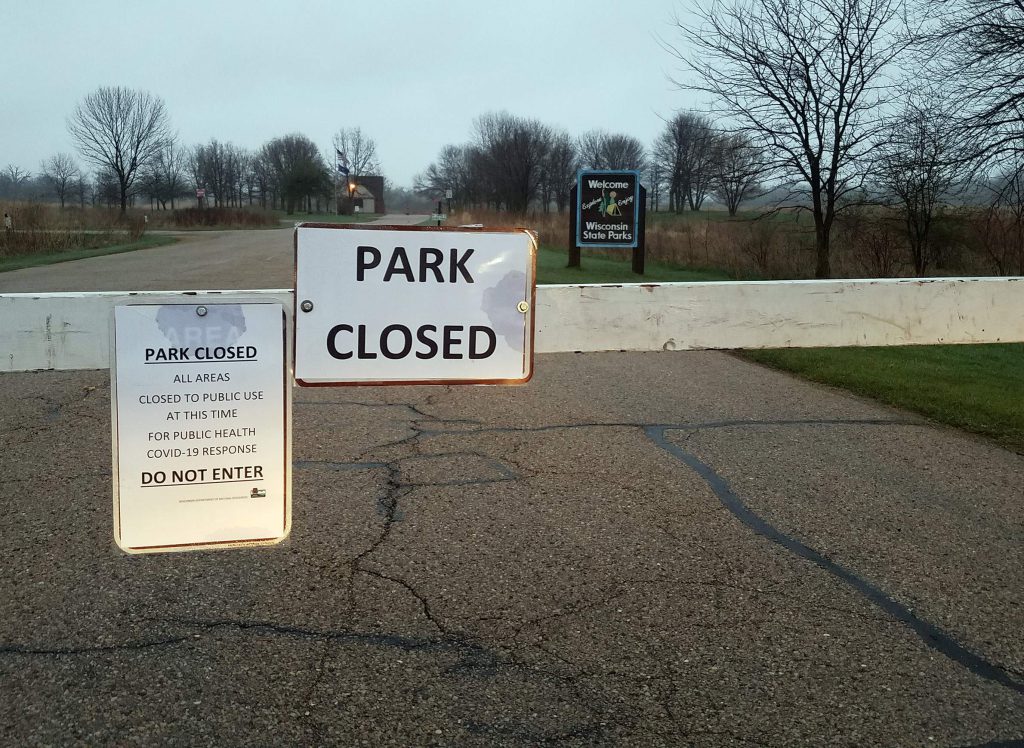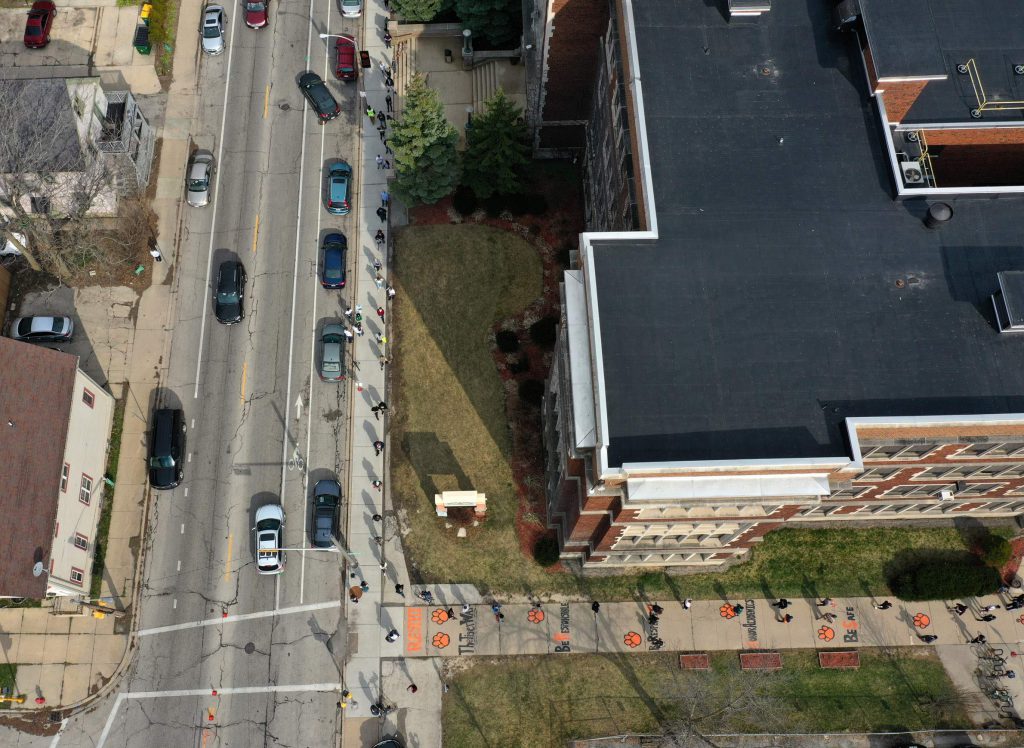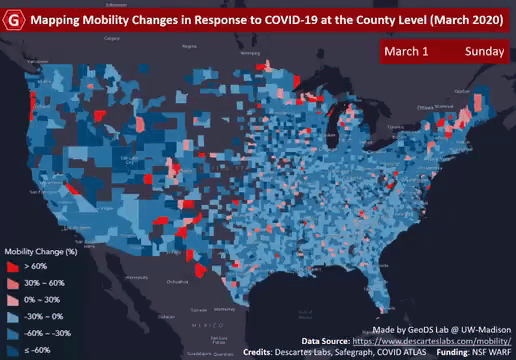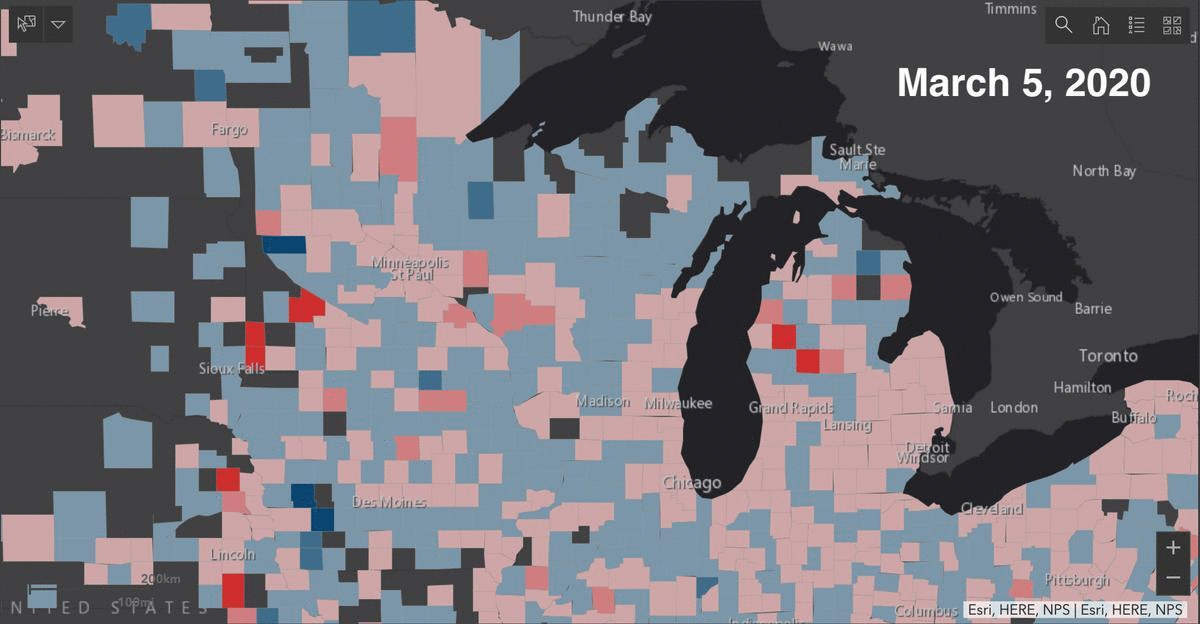Wisconsinites Starting To Ignore Stay-At-Home Order
State residents starting to experience “quarantine fatigue.”

Governor Nelson State Park in Dane County was one of dozens of state parks in Wisconsin ordered closed on April 9, 2020 due to overcrowding and other issues amid the COVID-19 pandemic. Most state parks were ordered to reopen on May 1 with reduced capacity limits, distancing requirements and other changes in place. This photo from April 29 shows a sign at a park entrance noting the closure. Photo by Kristian Knutsen/WisContext.
More than a month after Wisconsin directed residents to stay home as much as possible to slow the spread of COVID-19, adherence to the state’s “safer-at-home” order is beginning to erode. At least, the trends indicated by smartphone tracking data suggest that as 2020 drags on, a small but rising number of Wisconsinites are growing so weary of pandemic-driven changes to their lives that they’re reverting to prior routines.
Wisconsin’s stay-at-home order issued by Gov. Tony Evers commenced on March 24, following a week of escalating local and state government actions that prompted the closure of schools, as well as performance venues, restaurants, bars and other businesses across the state. The public health directive requires Wisconsin residents to work from home if possible and bars public or private gatherings of people outside of a single household.
Publicly available location tracking data demonstrate the quick effect of the stay-at-home order on the daily lives of Wisconsinites, as well as gradual shunning of its guidelines. These data come from smartphone users who have allowed various apps they’ve downloaded on their devices to monitor their location, sometimes even when not in use.
The reasons for opting into location tracking vary, but many smartphone users allow the feature for at least a few apps. Some app developers, such as Google and its parent company Alphabet, use location tracking for apps that provide navigation assistance or even to estimate how busy a store or restaurant is at a certain time of day. Other developers track users’ locations to provide targeted content or to facilitate ridesharing services.
In addition to its core functions for app developers, location tracking information can be valuable for other businesses and researchers who leverage it for any number of reasons, including targeted advertising and understanding the movement of people. To that end, many app developers sell location tracking data to third-party vendors who in turn use it to generate their own revenue, usually by aggregating and selling it again themselves. It is via these anonymized data samples shared publicly by some third-party vendors and app developers that the effects of Wisconsin’s stay-at-home order can be quantified.
For instance, location tracking data published publicly by Cuebiq, a New York-based data vendor usually focused on assisting retail marketing, show an easily discernible bump in the percentage of Wisconsin residents staying home in mid-March. That’s right as recognition that COVID-19 was a serious problem spurred a cascading flurry of voluntary business closures, event cancellations and public health orders that captured the attention and changed the behaviors of people around Wisconsin and the United States, though to varying degrees.
Tracking movement on Election Day
Mobility data can provide refined insights about the movements of Wisconsinites during the COVID-19 pandemic down to the levels of specific days and counties.
A group of researchers at the University of Wisconsin-Madison used data from multiple vendors to estimate the impact of in-person voting on movement patterns during Wisconsin’s election on April 7.
Local officials worried about the risk of transmission should voters gather in large numbers by turning out at polling places. Gov. Evers, a Democrat, attempted to delay in-person voting, but the Republican-led Wisconsin Legislature objected that the governor did not have the legal authority to unilaterally order the election’s delay, and that position was upheld by the conservative majority on the state Supreme Court.
Voting proceeded on April 7, with significantly reduced polling sites in Milwaukee, Green Bay and Waukesha, among other places, which resulted in long, snaking lines of voters, many of whom waited hours to cast their votes.
Numerous voters and voting rights activists denounced the Court’s decision to hold the election as scheduled, as many Wisconsinites were forced to choose between potentially risking their health and their right to vote, and argued the action amounted to a cynical attempt at voter suppression. Several weeks later, more than 50 people in the state who voted in-person or volunteered as poll workers had contracted COVID-19, though health officials could not say definitively whether any were infected while at the polls.

A line of voters outside a polling place at Riverside University High School in Milwaukee wraps around the school building, down the block, across a park, and into an adjacent neighborhood during Wisconsin’s election on April 7, 2020. Photo by Coburn Dukehart and Lauren Fuhrmann/Wisconsin Watch.
The UW-Madison group wanted to gauge to what degree the circumstances of the election affected voter behavior on Election Day. Using location tracking data, also commonly known as mobility data, they found that the median distance Wisconsinites traveled in many counties was higher on April 7 than other days during the stay-at-home order.
For instance, the researchers found that the median distance traveled in Waukesha County increased on April 7 to 1.2 miles from 0.7 miles the day before.
Despite the attention given to voting in urban areas, though, the increase was particularly seen in the state’s less populated regions. For example, median distance traveled in Lafayette County increased from 1.7 miles on April 6 to 2.8 miles April 7. Meanwhile, in Rock County, which includes both the more densely populated communities of Janesville and Beloit along with surrounding rural countryside, median travel ticked up from 1.2 miles to 1.7 miles over the same two days.
“The rural counties had a larger increase [in distance traveled] on April 7,” said Song Gao, an assistant professor of geography who is leading the interdisciplinary group’s location tracking efforts.
The work, funded through a National Science Foundation grant, centers on studying behaviors during the COVID-19 pandemic to improve epidemic modeling. This work also seeks to assess how scientists and health officials communicate with the public about the models’ inherent uncertainty and how that affects potential risks associated with them.

In latter half of March 2020, mobility across nearly all of the U.S. plummeted as more people stopped commuting or traveling in respon.se to the emerging COVID-19 pandemic. This graphic shows how these mobility changes can be viewed at the county level over the course of the month. Map by Jinmeng Rao/GeoDS Lab/UW-Madison.
The work of Gao and his collaborators could help inform eventual digital approaches to contact tracing in the U.S., whereby individuals could opt into an app built specifically for tracing their whereabouts in case they come into contact with someone who subsequently tests positive for COVID-19.
Indeed, a growing number of nations are leveraging location tracking data to assist with contact tracing. The United Kingdom is already preparing to roll out an opt-in app along the lines Gao described. However, Gao noted the group’s current research, based on anonymized and aggregated data, is very different from how a contact tracing app would work, and likewise different from how East Asian nations like Singapore and South Korea have used location data to track and trace individuals.
The concept is gaining traction in the U.S., including Utah, which released an early version of a contact tracing app in late April.
Gao noted effects of Wisconsin’s primary election on mobility were less apparent in large urban centers like Milwaukee and Madison, but were particularly pronounced in places like suburban Waukesha County as well as Lafayette County in rural southwest Wisconsin.
“The pattern we saw was not uniform across the state,” Gao said.
Where people are going, where they’re staying home
Mobility data can show how COVID-19 and the state’s stay-at-home order are not only scrambling democracy but completely uprooting the day-to-day aspects of Wisconsinites’ lives.
Using the vast amount of location tracking data its various apps and software collect, Google has published detailed information about what types of places people are avoiding and where they’re still going, with details available by nation, and in the U.S., by individual states.

Between the first week of March and the second week of April, travel by Wisconsinites dropped considerably, though movement increased in many counties during the April 7 election. In this graphic, darker red indicates longer travel trips compared to Feb. 1, while darker blue corresponds to shorter trips. Map by GeoDS Lab/UW-Madison.
Unsurprisingly, Google mobility data for Wisconsin show visits to retail stores and restaurants have cratered since mid-March, down between 40-60% compared to typical levels on most days. Travel to workplaces and transit stations has also fallen precipitously. Visits to grocery stores and pharmacies are down too, though not to the same degree. That’s likely an indication residents are continuing to shop for necessities while heeding public health guidelines to reduce visits to only essential needs.
The stay-at-home order’s effect on how many people are actually staying home is also apparent in the Google data, with about 20% more Wisconsin residents than usual not traveling more than 330 feet on any given work day.
Meanwhile, data show that visits to parks exploded over the early weeks of COVID-19 distancing. Yearning for some fresh air, as many as twice the number of people in Wisconsin visited parks on at least two days in early April compared to the typical number who do so. In response to the crowds and reports of vandalism at some busy state parks, Gov. Evers ordered a number of them, mostly in southern Wisconsin, closed on April 9.
Understanding how the pandemic and resulting public health orders affect trips to restaurants, shops, workplaces and parks is just one useful way to leverage mobility data. Other data vendors have broken down what portion of the population is staying home down to the county level.
Data from Cuebiq show that the number of people sticking close to home varies considerably around Wisconsin, with residents in Dane, Ozaukee and Waukesha counties doing so most, while those who live in Lafayette, Monroe and Lincoln counties are moving about to a greater degree.
The data can also be analyzed to understand how many more people are staying home in each county than they might otherwise. This information is useful because some counties, particularly those with an older population, have many more residents who regularly spend most of their time at home anyway. Analyzing the data this way shows that some urban and suburban counties, and most of those with four-year UW System campuses, have noticeably more residents staying home than in the weeks before COVID-19 hit the state compared to more rural counties, particularly in central and northern Wisconsin.
This pattern could very well be related to the types of employers of local workforces, according to Laura Dresser, an assistant professor at the UW-Madison School of Social Work and associate director of the UW economic research group COWS. Dresser studies Wisconsin’s workforce, particularly low-wage labor markets.
“The ability to work from home or to take your work home is very distributed by class,” she said. Professions that are typically better compensated in the labor market, including those in management, law, higher education, research and government, are usually much easier to move into a remote virtual setting than lower-wage jobs, she noted, particularly those in service industries.
Many lower-wage workers at restaurants, hotels and other businesses that have shut down have lost their jobs, while others who are employed in an industry deemed essential, including grocery, transit and nursing home workers, have continued reporting to work in-person during the pandemic. Because low-wage workers largely fall into these two camps — unemployed or essential and working on-site — Dresser said location tracking data may not clearly show the overall effect of the stay-at-home order on their mobility.
On the other hand, Dresser said counties with a large percentage of residents who work in management, law or higher education may show a greater percentage of people staying home than usual.
“There’s a lot of people in Dane County who work for the university, for the state,” she said, for whom “it’s imperfect when they move their work home, but they can.”
She added that similar dynamics are likely why suburban Milwaukee, including Waukesha, Washington and Ozaukee counties, and other counties with four-year UW campuses also show a higher number of people staying home than before COVID-19.
Measuring ‘quarantine fatigue’
Originally set to expire on April 24, Gov. Tony Evers subsequently extended Wisconsin’s COVID-19 stay-at-home order through May 26. Mobility data show it may be difficult to keep some Wisconsinites from bending the order’s rules or outright returning to some of their pre-pandemic habits outside the home through to the end of the order’s extension.
The rationale for the extension included an admission that testing for COVID-19 remains inadequate in Wisconsin despite an ongoing and major expansion of testing capacity among the state’s private and public health labs.
Even more significant is the fact that even as health officials tout statistics showing the stay-at-home order and other measures may be helping to “flatten the curve” of new infections in parts of the state, cases continue to climb, signaling the disease remains widely circulating in many communities.
As a result, public health officials worry that relaxing measures like “safer-at-home” more quickly, as some states in the southeastern U.S. have done, could prompt a resurgence in COVID-19 and overwhelm hospitals with critically ill patients, ultimately leading to many more deaths.
Indeed, by late April, confirmed cases of COVID-19 continued to rise significantly in Wisconsin, with the state’s largest and deadliest outbreak continuing to course through Milwaukee’s densely populated neighborhoods. Meanwhile, an explosion of cases tied to workers at meatpacking plants in Green Bay demonstrated the breathtaking ease by which the novel coronavirus responsible for COVID-19 can transmit between people in close quarters.
Still, so-called “quarantine fatigue” appears to be setting in around the state as a growing share of homebound Wisconsinites peer out their windows at greening foliage and wonder how much longer they — and their communities — can handle the economic and societal fallout of being cooped up and isolated from their families and friends.
This anxiety broke out in dramatic fashion on April 24, as about 1,500 protestors flouted the stay-at-home order and distancing guidelines to gather outside the state Capitol in Madison and denounce the state’s public health policies.
A co-owner of a real estate business, Leykin said he and his staff were able to continue working from home in response to the March 24 order. He initially viewed the measure as prudent in the face of the pandemic’s uncertainties. But then fatigue began setting in, and Leykin began hearing more and more anecdotes about struggling local businesses such as restaurants, and found himself questioning whether the order would ultimately do more harm than good.
“I stayed at home for three weeks,” he said. “It didn’t bother me much because I felt, like most people at the time, that staying home was justified, and a catastrophe to our society was being hampered or avoided. I started questioning it in my fourth week, and I started actively opposing it in my fifth week.”
Leykin said he became convinced the economic toll of an extended shutdown would have worse long-term ramifications than the virus. He has returned to working out of his office in Muskego, and surmised that many others who are able to have gone back to their offices as well. He observed that rush-hour traffic in Milwaukee seemed what he thought to be near normal levels during his evening commute on April 27.
“I no longer pay any attention to the lockdown. I go where I want to go when I want to go,” he said.
Mobility data from across Wisconsin show Leykin is not alone. Nearly across the board, in rural, suburban and urban counties, adherence to the state’s stay-at-home order has gradually fallen by as much as 10-15% since peaking in the first week after it took effect.
While the decline remains modest, and data show many people across the state continue to heed public health guidance to stay home, this downward trajectory points to a potential further erosion of adherence to the order into May.
“It’s certainly not surprising that there’s some fatigue” with the stay-at-home order, said Andrea Palm, secretary-designee of the Wisconsin Department of Health Services, in an April 27 media briefing. “I’m tired of it,” she conceded.
And yet, Palm reiterated her view, which aligns with the views of public health officials across the nation and internationally, that staying home and keeping the transmission of COVID-19 at a slow enough rate so it doesn’t overburden health systems is of utmost importance until infrastructure is in place to test, trace and isolate as many infected and exposed people as possible.
“What we know about ‘safer-at-home’ is it’s working,” Palm said. “We are flattening the curve and the people of this state have been unbelievably responsive and civic-minded about their role in keeping themselves safe and the broader community safe.”
Palm warned that if more Wisconsinites start ignoring the stay-at-home order, their actions are likely to accelerate COVID-19’s spread in the state. This reversal could wind up making a need to keep restrictions in place go on even longer.
Dr. Ryan Westergaard, the state epidemiologist for communicable diseases, underscored a few fundamental principles of epidemiology and successful outbreak control that will be required to ease movement restrictions.
They begin with and largely depend on minimizing community transmission as much as possible, which could only be accomplished by ongoing dedication among Wisconsinites to staying at home, he said during the April 27 media briefing.
Once the virus is slowed to a manageable level, Westergaard said the next phase of the state’s response would mean easing restrictions on movement and implementing a program of intensive testing, contact tracing, patient isolation and quarantine orders for those who are exposed to the virus.
“The next few weeks are going to be really critical for making sure we keep the epidemic at a manageable level,” he said.
Westergaard added an assurance for those weary of a homebound existence.
“There’s a light at the end of the tunnel,” he said. “What we’re building toward is a situation where we stop restricting everyone and we focus on just restricting the virus and the people that are infected.”
How Close Are Wisconsinites Sticking To Home As The COVID-19 Crisis Continues? was originally published on WisContext which produced the article in a partnership between Wisconsin Public Radio and PBS Wisconsin.
More about the Coronavirus Pandemic
- Governors Tony Evers, JB Pritzker, Tim Walz, and Gretchen Whitmer Issue a Joint Statement Concerning Reports that Donald Trump Gave Russian Dictator Putin American COVID-19 Supplies - Gov. Tony Evers - Oct 11th, 2024
- MHD Release: Milwaukee Health Department Launches COVID-19 Wastewater Testing Dashboard - City of Milwaukee Health Department - Jan 23rd, 2024
- Milwaukee County Announces New Policies Related to COVID-19 Pandemic - David Crowley - May 9th, 2023
- DHS Details End of Emergency COVID-19 Response - Wisconsin Department of Health Services - Apr 26th, 2023
- Milwaukee Health Department Announces Upcoming Changes to COVID-19 Services - City of Milwaukee Health Department - Mar 17th, 2023
- Fitzgerald Applauds Passage of COVID-19 Origin Act - U.S. Rep. Scott Fitzgerald - Mar 10th, 2023
- DHS Expands Free COVID-19 Testing Program - Wisconsin Department of Health Services - Feb 10th, 2023
- MKE County: COVID-19 Hospitalizations Rising - Graham Kilmer - Jan 16th, 2023
- Not Enough Getting Bivalent Booster Shots, State Health Officials Warn - Gaby Vinick - Dec 26th, 2022
- Nearly All Wisconsinites Age 6 Months and Older Now Eligible for Updated COVID-19 Vaccine - Wisconsin Department of Health Services - Dec 15th, 2022
Read more about Coronavirus Pandemic here





















